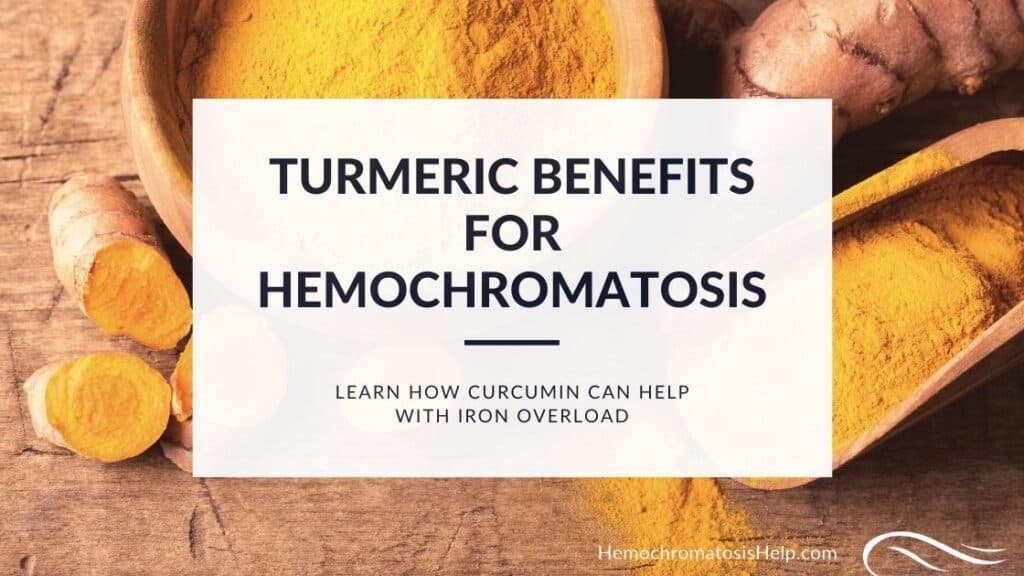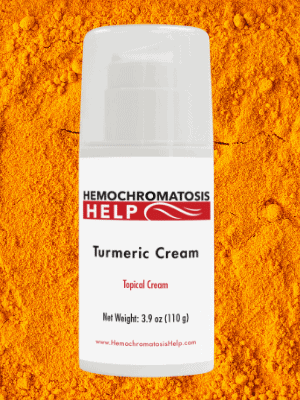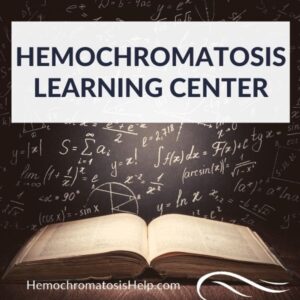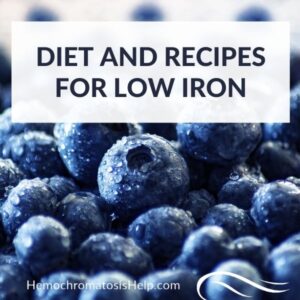Turmeric is an herb that gets a lot of attention these days.
It’s famous as a favorite anti-inflammatory herbal medicine, the chief ingredient in luscious curry dishes, and a gorgeous shade of orange that brightens every photograph it’s in.
It’s medicine, food, and brilliant color all in one!
What you might not already know is that turmeric is also supremely beneficial for hemochromatosis.
Why is turmeric helpful for hemochromatosis, you might ask?
It’s beneficial because it effectively removes iron from the cells of the body and lowers ferritin levels.
That’s a big deal!
As we know, excess iron builds up in hemochromatosis, causing damage and leading to the symptoms and problems of iron overload.
So I think you’ll be excited to know that turmeric literally grabs hold of the iron that’s inside your cells to bring it out! Once turmeric grabs hold of and binds to an iron molecule, the turmeric then helps the body excrete the iron from your body.
In this article, I will show you just how significant turmeric can be for reducing iron levels and improving many other aspects of our health.
I will also discuss the one major challenge to using turmeric medicinally and give you solutions so you can learn how to use this incredible herbal medicine correctly to make sure you receive its full benefits!
Let’s jump right in!
In This Article
Health Benefits of Turmeric in Hemochromatosis
Turmeric is one of the BEST nutritional supplements shown by clinical research to reduce iron build-up in the body.
Most significantly, turmeric can lower ferritin by chelating iron from the body.
Turmeric as an Iron Chelator and Ferritin Reducer
Chelate literally means “to claw,” and chelators are substances that work to remove the iron already stored in the body.
Take a look at the following graph and photo from a 2009 study evaluating the effect turmeric (aka curcumin) has on cellular iron levels:
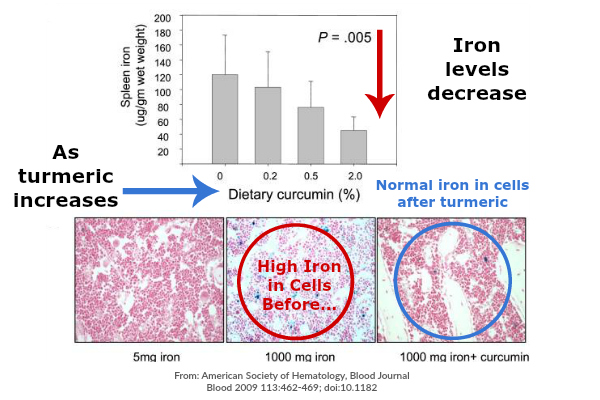
As you can clearly see, as levels of turmeric/curcumin increase, cellular iron levels decrease.
This study also demonstrates turmeric also has a powerful effect in reducing excess iron from our bloodstream, measured by markers such as plasma iron and transferrin saturation.
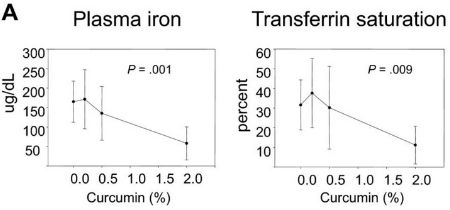
Fortunately for those of us with hemochromatosis, this research established that one of the many medicinal properties of turmeric is to reduce excess iron from both the bloodstream as well as the cells of the body.
In conclusion, the researchers from this study declared:
Curcumin is a biologically active iron chelator.
This is exceptional news for people with hemochromatosis and iron overload.
And that’s not all that turmeric can do for us!
Keep reading on to learn even more about how turmeric works in hemochromatosis.
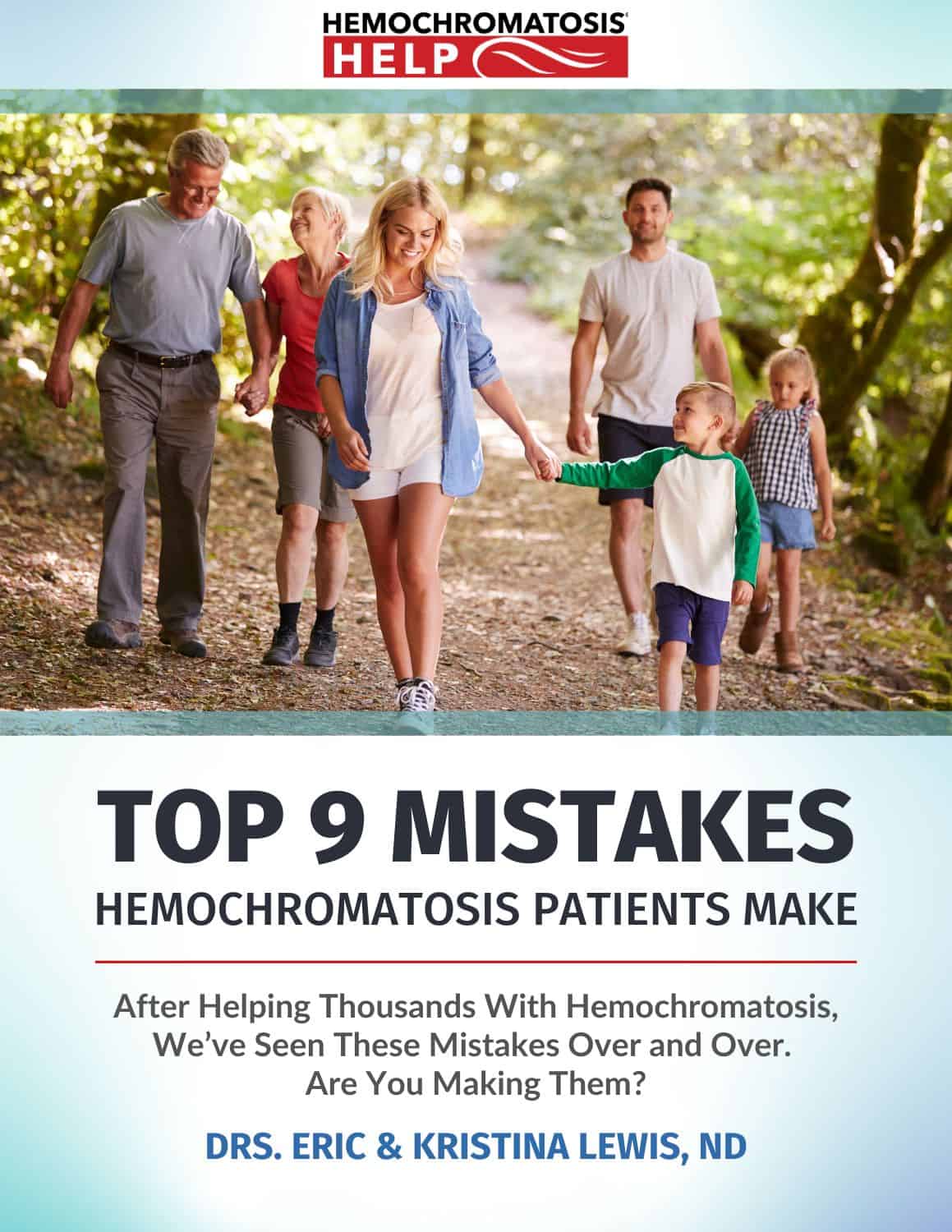
FREE GUIDE: TOP 9 MISTAKES HEMOCHROMATOSIS PATIENTS MAKE
After working with hemochromatosis patients over the past 10 years we have seen these mistakes over and over again including:
- Why when your doctor says “phlebotomy is the only thing you can do” they may not be completely correct
- The real importance of diet and supplementation for those with hemochromatosis
- Why Googling about hemochromatosis is one of the last things we recommend
- And much more…
Turmeric: Nature’s Best Anti-Inflammatory
Turmeric is a beautiful, flavorful, commonly used spice in cooking. Renowned for centuries with a rich, historical use in plant and herbal medicine, turmeric has long been held in high regard for its beneficial effects.
In general, turmeric and its active constituent, curcumin, have been shown to be an excellent anti-inflammatory supplement.
Inflammation is a widespread root cause of illness, suspected as a precipitating factor in a host of conditions such as heart disease, cancer, liver disease, kidney disease, diabetes, arthritis, hormonal imbalance… and, of course, hemochromatosis!
Inflammation can contribute to pain and fatigue, the primary hemochromatosis symptoms we all seem to suffer from.
A reduction in pain and fatigue alone would make the benefits of turmeric and curcumin worth exploring.
But to also reduce the storage of too much iron?!?
This is why I found myself doubly excited to learn of the medicinal benefits of turmeric.
Medicinal Properties of Turmeric
As if the reduction of excess iron, inflammation, and pain weren’t enough, a host of other properties have been attributed to turmeric supplements.
Among the most famous are:
- Antioxidant effects
- Immune supporter
- Energy production (healthy metabolism)
- Cognitive function enhancer
- Hormone balancer
- Promoter of restful sleep
When I found a remedy that is generally considered safe that also possesses so many beneficial properties, you can see why I’m so excited by the turmeric benefit to our health!

Would you like to read hemochromatosis success stories? Learn more here.

Would you like to learn more ways to help your hemochromatosis? Join our newsletter.
Supportive Research for Turmeric in Hemochromatosis
In addition to turmeric’s ferritin and transferrin saturation lowering abilities, this herbal remedy has been shown by researchers to have many additional potential benefits to a person with iron overload.
According to the FDA, turmeric is generally regarded as safe. Clinical evidence suggests this herbal remedy may be used as a complement to the most commonly recommended treatments for hemochromatosis: therapeutic phlebotomy and chelating medications.
Changes How the Body Metabolizes Iron
Fundamentally, turmeric positively supports the way the body metabolizes and handles iron.
The following study noted systemic iron depletion from curcumin (the most active constituent of turmeric):
“Curcumin has chemical properties consistent with iron chelator activity. The unexpected observation that cells treated with curcumin exhibited a decrease in ferritin raised the possibility that the chelator activity of curcumin might be sufficient to induce systemic iron depletion.” (Reference)
Talk about exciting research!
Body-wide reductions in elevated iron have been demonstrated in response to turmeric supplementation.
Fortunately, turmeric is associated with improvements in some of the most commonly affected organs and tissues by high iron, including the liver, spleen, heart, brain, nervous system, and joints.
Supports Liver Health & Lowers Liver Enzymes
The liver is the organ most vulnerable to damage from excess iron. Unchecked, this damage can contribute to liver disease.
Specifically, oxidative stress is one of the most impactful problems of hemochromatosis and is a primary reason liver cells become less healthy.
When oxidative damage occurs, a potential consequence is that liver enzymes such as ALT and AST leak into the bloodstream. Simple blood tests can measure for elevations in these enzymes, which doctors monitor with care.
Several studies evaluating turmeric’s effectiveness (curcumin) in iron overload have shown reductions in ALT and AST liver enzymes, along with a marker called NTBI (Non-Transferrin Bound Iron). NTBI is also known as “free iron” and is the most likely form of iron to cause oxidative stress.
“Curcumin administration alleviated iron burden and liver dysfunction by reducing NTBI, ALT, and AST levels in patients.” (Reference)
So, in addition to lowering ferritin levels, how does turmeric support liver health? What is the specific mechanism of action?
Research has also shown that turmeric increases the levels of a vital nutrient called glutathione!
Antioxidant that Raises Glutathione Levels
Glutathione is one of the most important antioxidants in our bodies. Its primary activity is inside our cells, placing glutathione in a perfect position to neutralize free radicals.
Since high iron levels contribute to oxidative stress, it makes sense that researchers have studied how glutathione levels interact with liver function.
One particular study demonstrated that glutathione reduces liver tissue damage, lowers liver enzymes, reduces inflammation, protects against oxidative damage, and possibly has iron chelation effects:
“To our surprise, glutathione reduced liver iron content and ferritin expression, denoting the possible iron chelation competency. (Reference)
Does turmeric raise glutathione levels?
Yes!
One study showed that turmeric could raise glutathione function by 20%. Another study found turmeric increased glutathione levels in the liver while markers of oxidative stress and iron levels were decreased.
High glutathione, less oxidation, and lower iron are precisely what we want when facing iron overload!
Works with Chelating Medicines
For individuals who are taking prescribed iron-chelating medications, it is interesting to note a study has shown a synergistic effect between turmeric and deferiprone and desferrioxamine.
There are many tools, both conventional and natural, that can help reduce elevated levels of iron, and it is great to see how they can work in a complementary fashion.
But did you know that how you take turmeric plays a significant role in if it will be effective for you or not?
How to Take Turmeric
There is one major challenge to using turmeric medicinally. The challenge is how to get the turmeric into the cells of your body.
Curcumin, the active ingredient in turmeric, tends to be poorly absorbed by our digestive system. I’ve seen estimates that place turmeric’s absorption at only about 5%, so you are not likely absorbing much from diet alone.
Ordinary turmeric powders, pills, or teas, are only going to be used by your body a tiny amount. Oral absorption of curcumin is generally poor due to its low solubility and instability in the intestinal environment.
Additionally, a very common ingredient frequently added to turmeric supplements may be a poor choice for a person with hemochromatosis. Be sure to read why you shouldn’t use black pepper with turmeric.
Fortunately, there are two optimal ways to absorb turmeric and therefore gain its exceptional benefits:
Topical Turmeric Cream
The first optimal way to absorb turmeric is to use a topical application. A topical cream of turmeric gets absorbed directly into the body, bypassing the gut to ensure maximal results.
In addition to superior absorption, a topical skin application is easy and convenient to use. This is what makes Hemochromatosis Help’s Turmeric Cream the most popular supplement on our site.
Enhanced Turmeric Capsules
The second recommended option is to use a special form of turmeric capsule with enhanced methods of absorption.
Hemochromatosis Help’s Turmeric Capsules provides the patented BCM-95® brand of turmeric, a special form of turmeric with enhanced absorption methods.
Laboratory testing has shown BCM-95® greatly increases curcumin stability and significantly enhances oral absorption compared to ordinary curcumin. To date, it has been the subject of more than 21 published studies and has been researched worldwide for over 12 years.
This innovative product takes the naturally occurring essential oils from turmeric to synergistically enhance the absorption of the curcuminoids. This process significantly improves the turmeric’s absorption and lasting effects to provide the most benefit for the body!
This 100% whole turmeric formula creatively uses the natural essential oils already found in pure turmeric to provide superior absorption that lasts up to 8 hours.
TURMERIC STUDIES (Iron Related):
Messner, D.J., Surrago, C., Fiordalisi, C. et al. Isolation and characterization of iron chelators from turmeric (Curcuma longa): selective metal binding by curcuminoids. Biometals 30, 699–708 (2017). https://link.springer.com/article/10.1007/s10534-017-0038-6
Montanino C, Farinella F, De Felice B, Del Buono A, D’Orta A. The Potential Systemic Anti-Inflammatory Effect of Turmeric Dried Extract. Endocr Metab Immune Disord Drug Targets. 2025 Jan 8. https://pubmed.ncbi.nlm.nih.gov/39791174/
Srichairatanakool, S., Thephinlap, C., Phisalaphong, C., Porter, J. B., and Fucharoen, S. Curcumin contributes to in vitro removal of non-transferrin bound iron by deferiprone and desferrioxamine in thalassemic plasma. Med.Chem. 2007;3(5):469-474. https://pubmed.ncbi.nlm.nih.gov/17897073/
Jiao, Y., Wilkinson, J., Christine, Pietsch E., Buss, J. L., Wang, W., Planalp, R., Torti, F. M., and Torti, S. V. Iron chelation in the biological activity of curcumin. Free Radic.Biol.Med. 4-1-2006;40(7):1152-1160. https://pubmed.ncbi.nlm.nih.gov/16545682/
Jiao, Y., Wilkinson, J., Di, X., Wang, W., Hatcher, H., Kock, N. D., D’Agostino, R., Jr., Knovich, M. A., Torti, F. M., and Torti, S. V. Curcumin, a cancer chemopreventive and chemotherapeutic agent, is a biologically active iron chelator. Blood 1-8-2009;113(2):462-469. https://www.ncbi.nlm.nih.gov/pmc/articles/PMC2615657/
Tuntipopipat, S., Zeder, C., Siriprapa, P., and Charoenkiatkul, S. Inhibitory effects of spices and herbs on iron availability. Int.J Food Sci.Nutr. 2009;60 Suppl 1:43-55. https://pubmed.ncbi.nlm.nih.gov/18651292/
Tuntipopipat, S., Judprasong, K., Zeder, C., Wasantwisut, E., Winichagoon, P., Charoenkiatkul, S., Hurrell, R., and Walczyk, T. Chili, but not turmeric, inhibits iron absorption in young women from an iron-fortified composite meal. J Nutr. 2006;136(12):2970-2974. https://pubmed.ncbi.nlm.nih.gov/17116705/
Baum, L. and Ng, A. Curcumin interaction with copper and iron suggests one possible mechanism of action in Alzheimer’s disease animal models. J Alzheimers.Dis. 2004;6(4):367-377. https://pubmed.ncbi.nlm.nih.gov/15345806/
Ishihara, M. and Sakagami, H. Re-evaluation of cytotoxicity and iron chelation activity of three beta-diketones by semiempirical molecular orbital method. In Vivo 2005;19(1):119-123. https://pubmed.ncbi.nlm.nih.gov/15796163/
Bernabe-Pineda, M., Ramirez-Silva, M. T., Romero-Romo, M. A., Gonzalez-Vergara, E., and Rojas-Hernandez, A. Spectrophotometric and electrochemical determination of the formation constants of the complexes Curcumin-Fe(III)-water and Curcumin-Fe(II)-water. Spectrochim.Acta A Mol.Biomol.Spectrosc. 2004;60(5):1105-1113. https://pubmed.ncbi.nlm.nih.gov/15084330/
Reddy, A. C. and Lokesh, B. R. Effect of dietary turmeric (Curcuma longa) on iron-induced lipid peroxidation in the rat liver. Food Chem.Toxicol 1994;32(3):279-283. https://pubmed.ncbi.nlm.nih.gov/8157223/
Reddy, A. C. and Lokesh, B. R. Studies on the inhibitory effects of curcumin and eugenol on the formation of reactive oxygen species and the oxidation of ferrous iron. Mol.Cell Biochem. 8-17-1994;137(1):1-8. https://pubmed.ncbi.nlm.nih.gov/7845373/
Reddy, A. C. and Lokesh, B. R. Effect of curcumin and eugenol on iron-induced hepatic toxicity in rats. Toxicology 1-22-1996;107(1):39-45. https://pubmed.ncbi.nlm.nih.gov/8597030/
Mandel, S., Amit, T., Bar-Am, O., and Youdim, M. B. Iron dysregulation in Alzheimer’s disease: multimodal brain permeable iron chelating drugs, possessing neuroprotective-neurorescue and amyloid precursor protein-processing regulatory activities as therapeutic agents. Prog.Neurobiol. 2007;82(6):348-360. https://pubmed.ncbi.nlm.nih.gov/17659826/
Jyoti, A., Sethi, P., and Sharma, D. Curcumin protects against electrobehavioral progression of seizures in the iron-induced experimental model of epileptogenesis. Epilepsy Behav. 2009;14(2):300-308. https://pubmed.ncbi.nlm.nih.gov/19100339/
Thephinlap, C., Phisalaphong, C., Lailerd, N., Chattipakorn, N., Winichagoon, P., Vadolus, J., Fucharoen, S., Porter, J. B., and Srichairatanakool, S. Reversal of cardiac iron loading and dysfunction in thalassemic mice by curcuminoids. Med Chem 2011;7(1):62-69. https://pubmed.ncbi.nlm.nih.gov/21235521/
Thephinlap C, Phisalaphong C, Fucharoen S, Porter JB, Srichairatanakool S. Efficacy of curcuminoids in alleviation of iron overload and lipid peroxidation in thalassemic mice. Med Chem. 2009 Sep;5(5):474-82. https://pubmed.ncbi.nlm.nih.gov/19534681/
Milman NT. A Review of Nutrients and Compounds, Which Promote or Inhibit Intestinal Iron Absorption: Making a Platform for Dietary Measures That Can Reduce Iron Uptake in Patients with Genetic Haemochromatosis. J Nutr Metab. 2020 Sep 14;2020:7373498. https://www.ncbi.nlm.nih.gov/pmc/articles/PMC7509542/
Mohammadi E, Tamaddoni A, Qujeq D, Nasseri E, Zayeri F, Zand H, Gholami M, Mir SM. An investigation of the effects of curcumin on iron overload, hepcidin level, and liver function in β-thalassemia major patients: A double-blind randomized controlled clinical trial. Phytother Res. 2018 Sep;32(9):1828-1835. https://pubmed.ncbi.nlm.nih.gov/29806132/
TOPICAL APPLICATION OF TURMERIC STUDIES:
Hegge AB1, Schüller RB, Kristensen S, Tønnesen HH. In vitro release of curcumin from vehicles containing alginate and cyclodextrin. Studies of curcumin and curcuminoides. XXXIII. Pharmazie. 2008 Aug;63(8):585-92.
Teichmann A1, Heuschkel S, Jacobi U, Presse G, Neubert RH, Sterry W, Lademann J. Comparison of stratum corneum penetration and localization of a lipophilic model drug applied in an o/w microemulsion and an amphiphilic cream. Eur J Pharm Biopharm. 2007 Nov;67(3):699-706.
(**Note: In respect to the above study, our Turmeric Cream is a “microemulsion” preparation and not a “amphiphillic” preparation)
Fang JY1, Hung CF, Chiu HC, Wang JJ, Chan TF. Efficacy and irritancy of enhancers on the in-vitro and in-vivo percutaneous absorption of curcumin. J Pharm Pharmacol. 2003 May;55(5):593-601.
Fang JY1, Hung CF, Chiu HC, Wang JJ, Chan TF. Efficacy and irritancy of enhancers on the in-vitro and in-vivo percutaneous absorption of curcumin. J Pharm Pharmacol. 2003 Aug;55(8):1175.
Patel NA1, Patel NJ, Patel RP. Design and evaluation of transdermal drug delivery system for curcumin as an anti-inflammatory drug. Drug Dev Ind Pharm. 2009 Feb;35(2):234-42.
H Moghimi, B Shahmir, A Zarghi. Enhancement of percutaneous absorption of curcumin (turmeric pigment) by ethanol. IJPR. Iranian Journal of Pharmaceutical Research. Article 21, Volume 3, Supplement 2, Autumn 2004, Pages 8-9.
(**Note: In respect to the above study, our Turmeric Cream contains alcohol as an ingredient to enhance absorption)
RESEARCH ON GENERAL BENEFITS OF TURMERIC & GLUTATHIONE:
Jurenka JS. Anti-inflammatory properties of curcumin, a major constituent of Curcuma longa: a review of preclinical and clinical research. Altern Med Rev. 2009 Jun;14(2):141-53. Erratum in: Altern Med Rev. 2009 Sep;14(3):277. PMID: 19594223. https://pubmed.ncbi.nlm.nih.gov/19594223/
Menon VP, Sudheer AR. Antioxidant and anti-inflammatory properties of curcumin. Adv Exp Med Biol. 2007;595:105-25. https://pubmed.ncbi.nlm.nih.gov/17569207/
Aggarwal BB, Harikumar KB. Potential therapeutic effects of curcumin, the anti-inflammatory agent, against neurodegenerative, cardiovascular, pulmonary, metabolic, autoimmune and neoplastic diseases. Int J Biochem Cell Biol. 2009 Jan;41(1):40-59. https://www.ncbi.nlm.nih.gov/pmc/articles/PMC2637808/
Antony B, Merina B, Iyer VS, Judy N, Lennertz K, Joyal S. A Pilot Cross-Over Study to Evaluate Human Oral Bioavailability of BCM-95CG (Biocurcumax), A Novel Bioenhanced Preparation of Curcumin. Indian J Pharm Sci. 2008 Jul-Aug;70(4):445-9. https://www.ncbi.nlm.nih.gov/pmc/articles/PMC2792534/
Shehzad A, Rehman G, Lee YS. Curcumin in inflammatory diseases. Biofactors. 2013 Jan-Feb;39(1):69-77. https://pubmed.ncbi.nlm.nih.gov/23281076/
Ramadan G, Al-Kahtani MA, El-Sayed WM. Anti-inflammatory and anti-oxidant properties of Curcuma longa (turmeric) versus Zingiber officinale (ginger) rhizomes in rat adjuvant-induced arthritis. Inflammation. 2011 Aug;34(4):291-301. https://pubmed.ncbi.nlm.nih.gov/21120596/
Samir Salama SA, et al., Glutamyl cysteine dipeptide suppresses ferritin expression and alleviates liver injury in iron-overloaded rat model, Biochimie 115 (2015): 203-11. https://www.sciencedirect.com/science/article/abs/pii/S0300908415001777
Professional Quality Supplements Hand-Picked by the Naturopathic Doctors at Hemochromatosis Help.
Related Articles & Links:
- Using Nutritional Supplements in Hemochromatosis
- Supplements Created for the Hemochromatosis Patient
- Benefits of Quercetin in Hemochromatosis
- Benefits of Resveratrol in Hemochromatosis
- Benefits of Milk Thistle in Hemochromatosis
- Benefits of Green Tea in Hemochromatosis
- Benefits of Calcium in Hemochromatosis

